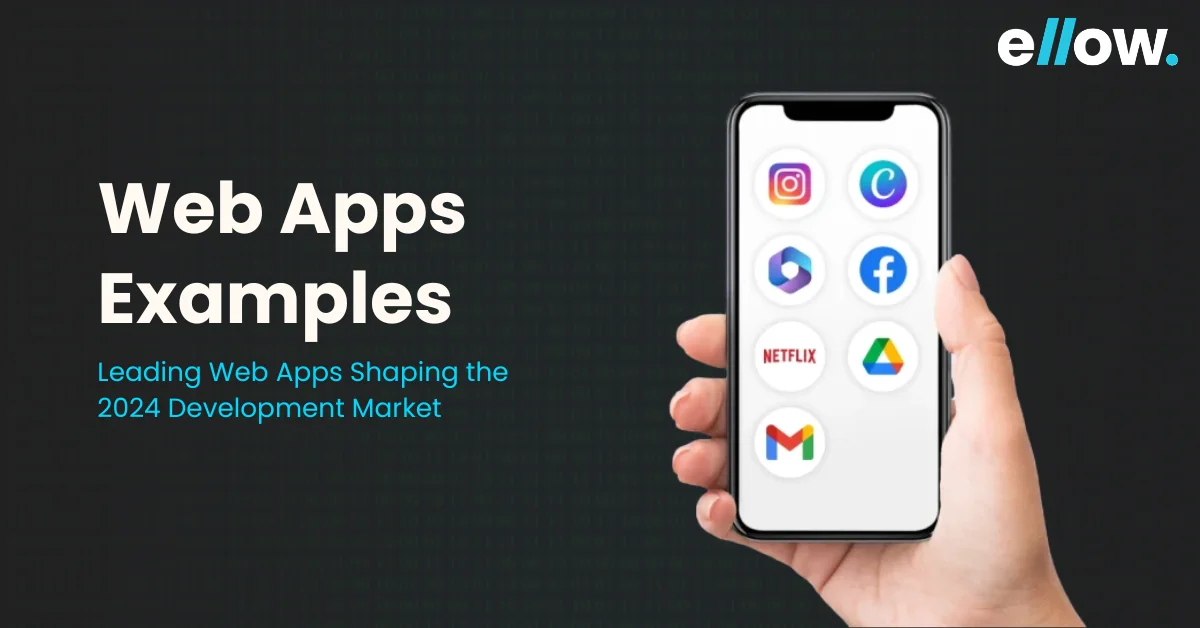Let’s build the future together.
Great ideas need great people. Partner with us to bring your vision to life, or take the first step in your career by joining our team of innovators.
Receive new articles delivered Straight to your inbox

Web applications have revolutionized the digital world, becoming indispensable tools for businesses and individuals. Their importance spans multiple industries, facilitating everything from social media interactions to business operations.
The surge in web app usage is supported by the growing number of developers, which Statista predicts will surpass 27 million by 2024.
Web apps provide high-performance and cost-effective solutions, supported by tech leaders like Google. They enhance efficiency in marketing and customer service, helping companies operate more smoothly.
This article highlights the top web applications dominating the market in 2024, illustrating their significant role in today’s digital ecosystem. Whether you are looking to innovate or streamline your business processes, these examples offer valuable insights and inspiration.
Dive in to discover the leading web apps that are shaping the future of digital interaction and driving business success.
Web applications are software programs that run on web servers and are accessed through web browsers. Unlike traditional desktop applications that are installed and run on individual computers, web applications use the internet to deliver functionality to users.
Static web applications are the simplest form of web applications. They display fixed content that does not change unless manually updated by the developer.
Examples include portfolio websites, company brochures, and personal blogs. They are easy to develop and host but offer limited interactivity and personalization.
Dynamic web applications generate content in real time based on user interactions and server-side processing. Examples include social media platforms, e-commerce sites, and content management systems (CMS).
They provide a more interactive and personalized user experience but require more complex development and server resources.
Single-page applications load a single HTML page and dynamically update content as the user interacts with the app, without refreshing the entire page.
Examples include Gmail, Google Maps, and Facebook. SPAs offer a seamless user experience with fast and responsive interfaces but can be complex to develop and require efficient client-side scripting.
Progressive web applications combine the best features of web and mobile applications. They are designed to work offline, load quickly, and provide a native app-like experience on any device.
Examples include Twitter Lite, Starbucks, and Pinterest. PWAs are highly responsive, offer improved performance, and can be added to the home screen of mobile devices.
E-commerce web applications facilitate online buying and selling of goods and services. Examples include Amazon, eBay, and Shopify.
These applications require robust functionality to handle product listings, shopping carts, payment processing, and customer accounts. They offer significant business opportunities but demand secure and scalable infrastructure.
Content management systems allow users to create, manage, and modify digital content without requiring technical knowledge. Examples include WordPress, Joomla, and Drupal.
CMS platforms are popular for building and managing websites, blogs, and online stores, providing ease of use and flexibility in content creation.
Enterprise web applications are designed to meet the needs of large organizations. Examples include Customer Relationship Management (CRM) systems like Salesforce and Enterprise Resource Planning (ERP) systems like SAP.
These applications support complex business processes, data management, and integration with other enterprise systems.
Social networking web applications enable users to connect, communicate, and share content with others. Examples include Facebook, Twitter, and LinkedIn.
They provide features like user profiles, messaging, content sharing, and notifications, fostering online communities and interactions.
Web portals aggregate information from various sources and present it in a unified interface. Examples include Yahoo, MSN, and government portals. They offer a range of services such as news, email, forums, and search engines, catering to diverse user needs in one place.
Online forums and communities allow users to participate in discussions, share knowledge, and interact with others who have similar interests.
Examples include Reddit, Stack Overflow, and Quora. These platforms provide features like threads, voting, and moderation to facilitate structured and engaging discussions.
Check this video out: WHAT IS WEB APP | Websites Vs Web Applications | Web Based Application
Facebook continues to be a dominant social media platform, enabling users to connect with friends, family, and communities. It offers an array of features such as status updates, photo and video sharing, live streaming, and event planning.
The platform’s robust algorithm curates a personalized news feed, ensuring relevant content for each user. Additionally, Facebook Groups foster community engagement around shared interests, and Facebook Marketplace facilitates local buying and selling.
Twitter remains a powerful microblogging service where users share concise messages called tweets. It’s a go-to platform for real-time updates on news, trends, and conversations worldwide. Twitter’s hashtag system categorizes content, making it easy to follow specific topics.
Users can engage through likes, retweets, and replies, fostering dynamic interactions. Twitter Spaces, an audio chat feature, allows live conversations, enhancing the platform’s interactivity.
Slack is a premier communication tool for businesses and organizations, streamlining team collaboration. It organizes conversations into channels based on projects, topics, or teams, ensuring focused discussions.
Direct messaging allows private conversations, while integrations with other tools like Google Drive and Trello enhance productivity. Slack’s searchable archive makes retrieving past conversations and shared files effortlessly, ensuring crucial information is always accessible.
Google Workspace, formerly G Suite, is a comprehensive suite of cloud-based productivity tools. It includes Gmail for email, Google Drive for storage, Docs for word processing, Sheets for spreadsheets, and Meet for video conferencing.
These tools support real-time collaboration, enabling multiple users to work on the same document simultaneously. Google Workspace’s seamless integration across devices ensures consistent productivity, whether on a desktop, tablet, or smartphone.
Microsoft 365 combines traditional desktop applications like Word, Excel, and PowerPoint with cloud services such as OneDrive and Teams. This suite enhances productivity through features like real-time co-authoring, cloud storage, and advanced data analysis tools.
Microsoft Teams provides a hub for teamwork, integrating chat, video meetings, and file collaboration in one platform. The integration of AI and machine learning in Microsoft 365 applications further boosts efficiency by offering intelligent suggestions and automation.
Trello is a visual project management tool that uses boards, lists, and cards to help teams organize tasks and workflows. Each card represents a task and can include descriptions, attachments, comments, and due dates. Trello’s drag-and-drop interface makes it easy to move tasks through different stages of completion.
Power-Ups extend Trello’s functionality, integrating it with other tools like Slack, Google Drive, and Jira. Trello’s flexibility and simplicity make it ideal for various project types, from agile development to personal task management.
Amazon remains the largest online marketplace, offering a vast selection of products from electronics to groceries. Its Prime membership provides benefits like free two-day shipping, access to streaming services, and exclusive deals. Amazon’s recommendation algorithm suggests products based on user behavior, enhancing the shopping experience.
The platform also supports third-party sellers, providing tools for inventory management, order fulfillment, and customer service. Amazon Web Services (AWS) further solidifies Amazon’s dominance, offering scalable cloud computing solutions to businesses.
Shopify is a leading e-commerce platform that empowers businesses to create and manage online stores. It offers customizable templates, a secure payment gateway, and tools for tracking sales and customer behavior. Shopify’s app store provides additional functionalities, such as email marketing, inventory management, and social media integration.
The platform supports multi-channel selling, allowing businesses to sell on their website, social media, and marketplaces like Amazon and eBay. Shopify’s robust analytics help merchants optimize their operations and marketing strategies.
eBay is a versatile online marketplace known for its auction-style listings, as well as fixed-price sales. It attracts a wide range of buyers and sellers, offering everything from collectibles and electronics to fashion and home goods. eBay’s bidding system allows users to compete for items, often resulting in significant bargains.
The platform’s buyer protection ensures secure transactions, while seller tools facilitate listing management, inventory tracking, and customer communication. eBay’s global reach and diverse product range make it a preferred platform for both casual and professional sellers.
Netflix is the premier streaming service for movies, TV shows, and original content. With a vast library and personalized recommendations, Netflix caters to diverse viewing preferences. Subscribers can stream content on multiple devices, from smart TVs to mobile phones, ensuring entertainment on the go.
Netflix Originals, such as “Stranger Things” and “The Crown,” have garnered critical acclaim, enhancing the platform’s reputation. Features like offline viewing and customizable profiles further enrich the user experience.
Spotify is a leading music streaming service offering access to millions of songs, albums, and podcasts. Users can create and share playlists, discover new music through personalized recommendations, and enjoy curated playlists for different moods and activities. Spotify Premium provides an ad-free experience, offline listening, and higher sound quality.
The platform’s integration with social media allows users to share their listening habits and collaborate on playlists. Spotify’s podcast library has expanded significantly, making it a one-stop platform for both music and spoken word content.
YouTube is the largest video-sharing platform, where users upload, view, and engage with content. It offers a vast array of videos, from educational tutorials and vlogs to music videos and live streams. YouTube’s recommendation algorithm suggests videos based on user preferences, ensuring a personalized viewing experience.
The platform supports content creators through the YouTube Partner Program, enabling monetization through ads and channel memberships. YouTube Premium offers an ad-free experience, background play, and access to YouTube Originals.
PayPal is a secure online payment system widely used for personal and business transactions. It allows users to send and receive money, make purchases, and manage finances through a single platform. PayPal’s buyer protection and fraud prevention mechanisms ensure secure transactions.
Businesses can integrate PayPal for seamless checkout experiences, supporting various payment methods, including credit cards and bank transfers. PayPal’s global reach and ease of use make it a preferred payment solution for millions of users.
Stripe is a comprehensive payment processing platform designed for online businesses. It supports a wide range of payment methods, including credit and debit cards, mobile wallets, and international currencies.
Stripe’s powerful APIs enable custom integrations, allowing businesses to build tailored payment solutions.
Features like subscription billing, invoicing, and fraud detection tools enhance Stripe’s utility for different business models. Stripe’s robust analytics provide insights into transaction trends, helping businesses optimize their payment processes.
Robinhood is an innovative investment app offering commission-free trading of stocks, ETFs, and cryptocurrencies. It democratizes finance by providing an accessible platform for beginners and seasoned investors alike.
Robinhood’s intuitive interface simplifies the trading process, while features like fractional shares and recurring investments allow for flexible portfolio management.
The app also offers educational resources and market data to help users make informed investment decisions. Robinhood’s mission to make investing accessible has attracted a large user base, particularly among younger investors.
Web apps have revolutionized business operations by enhancing efficiency and accessibility. They allow businesses to streamline processes, improve customer engagement, and facilitate remote work.
With web apps, businesses can operate seamlessly across various devices and platforms, ensuring consistent user experiences.
Web apps simplify complex business operations. They automate repetitive tasks, reducing manual effort and minimizing errors. Real-time data access and collaboration tools enable teams to work more effectively.
Moreover, web apps support scalable growth, allowing businesses to adapt quickly to market changes.
The future of web app development is geared towards greater personalization, enhanced security, and the integration of artificial intelligence. Progressive Web Apps (PWAs) will become more prevalent, offering offline capabilities and improved performance.
Additionally, businesses will focus on creating more intuitive and user-friendly interfaces to meet the evolving needs of their customers.
Web applications have reshaped the digital landscape in 2024, setting new standards for both functionality and user experience. They highlight the importance of anticipating and meeting user needs in an increasingly digital world.
As web apps continue to dominate the market, they exemplify the drive to enhance human connections and improve quality of life through technology. The evolution of these applications offers valuable lessons and inspiration for future innovations.
For those looking to hire top-notch web app developers, platforms like ellow.io offer a streamlined and efficient way to find the right talent. With the right developers, your web applications can become a vital part of the digital future.
The opportunities are vast, and with the right approach, the future holds immense potential.
Web apps are software applications that run on web servers and are accessed through web browsers. They don’t need to be downloaded or installed on a device, making them highly accessible.
In 2024, web apps are popular due to their accessibility, cross-platform compatibility, and ease of updates. They offer seamless user experiences and can be used on various devices without the need for multiple versions.
Popular web apps in 2024 include collaboration tools like Slack, project management software like Trello, social media platforms like Instagram, and e-commerce sites like Amazon. These apps dominate the market due to their functionality and user-friendly interfaces.
Web apps benefit businesses by providing scalable and cost-effective solutions. They improve accessibility for users, allow for easy updates and maintenance, and support a wide range of functionalities that enhance productivity and customer engagement.
You can hire skilled web app developers through platforms like ellow.io. These platforms connect you with experienced developers who can help bring your web app ideas to life, ensuring high-quality and efficient development processes.

How Top SaaS Companies Build Agile Teams with Remote Developers

How to Hire Vetted Remote Developers in a Hyper-Competitive Market

Top 5 Countries to Hire Remote Developers (and Why)
Please feel free to share your thoughts and we can discuss it over a cup of tea.
Get a quote
How Top SaaS Companies Build Agile Teams with Remote Developers

Six Things to Consider When Hiring Remote Talent

ellow.io enters remote hires market with AI-based screening process
Great ideas need great people. Partner with us to bring your vision to life, or take the first step in your career by joining our team of innovators.
Looking to build your career in development? team@ellow.io